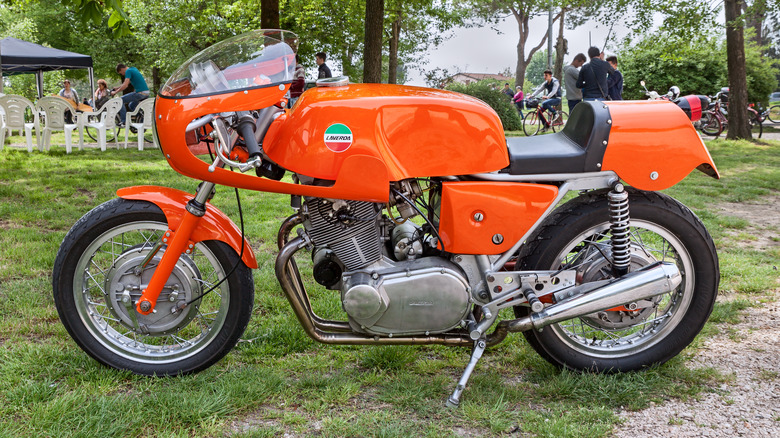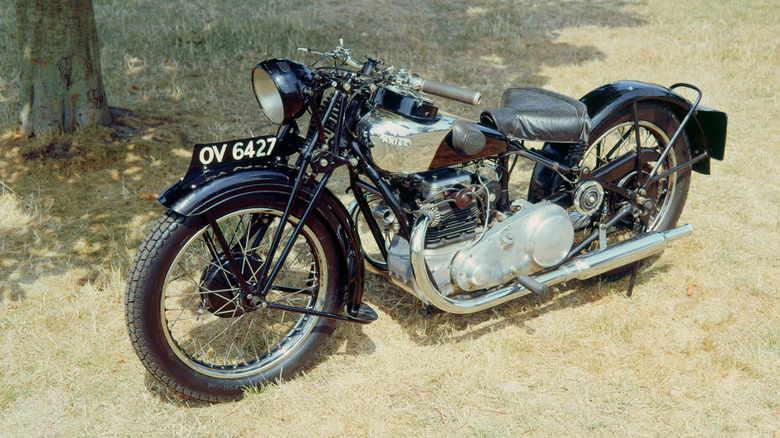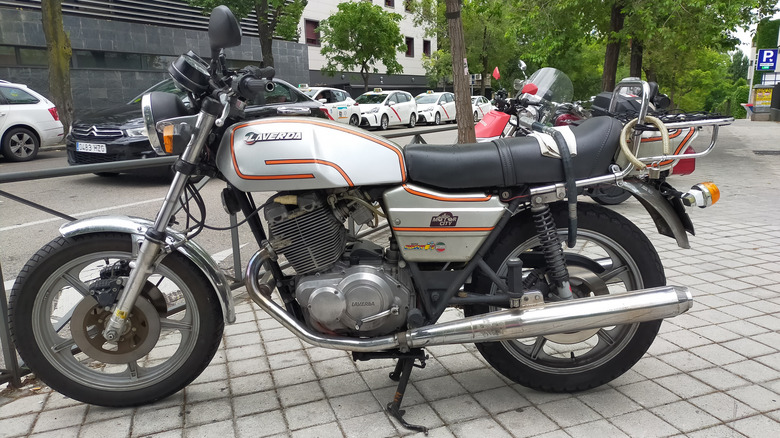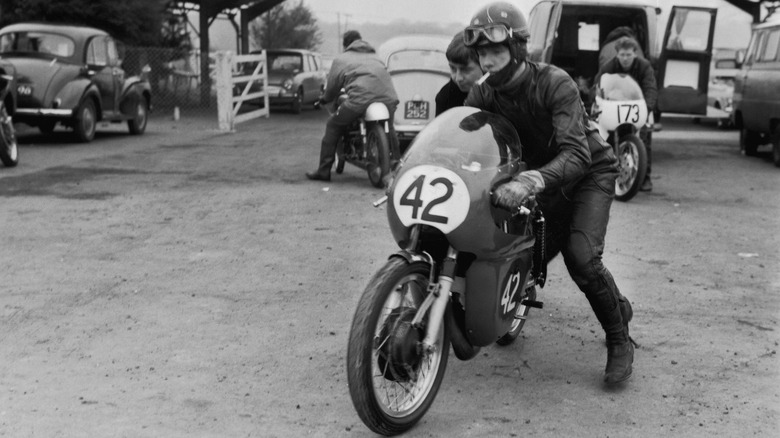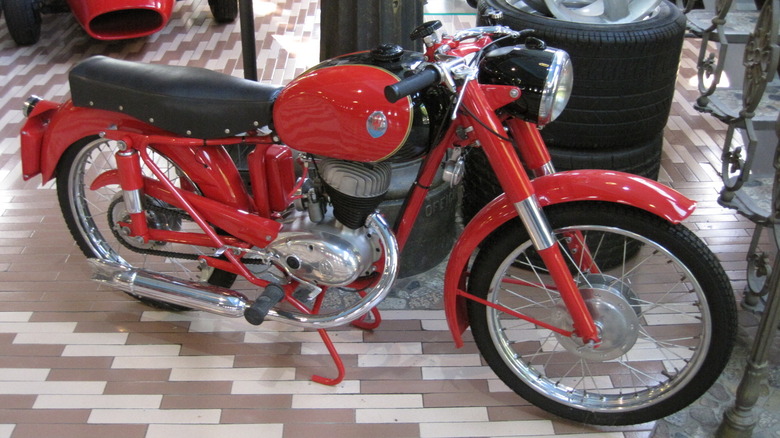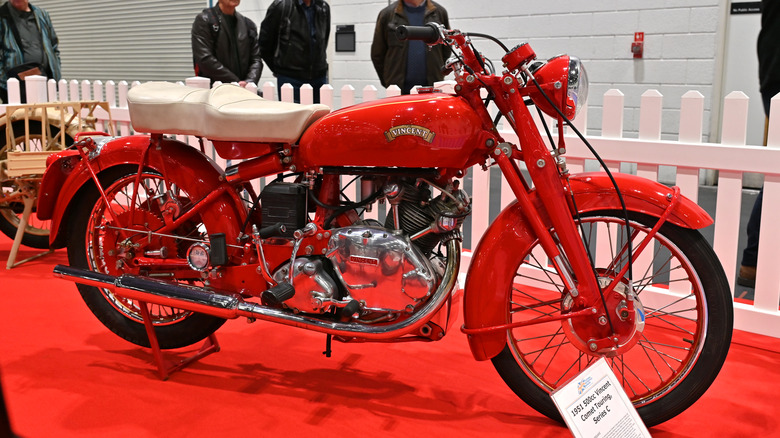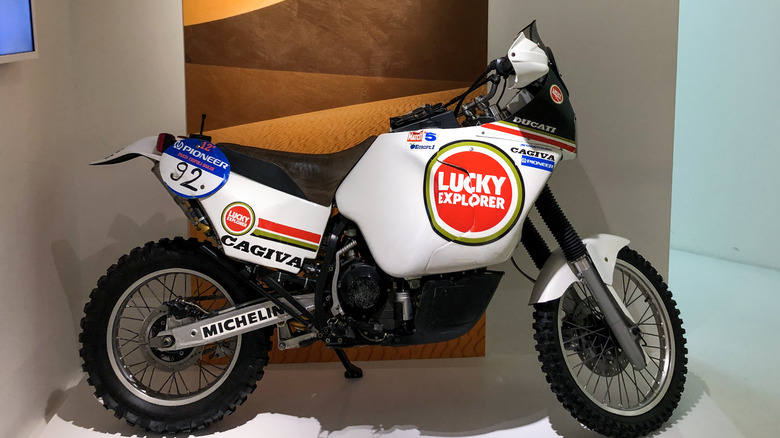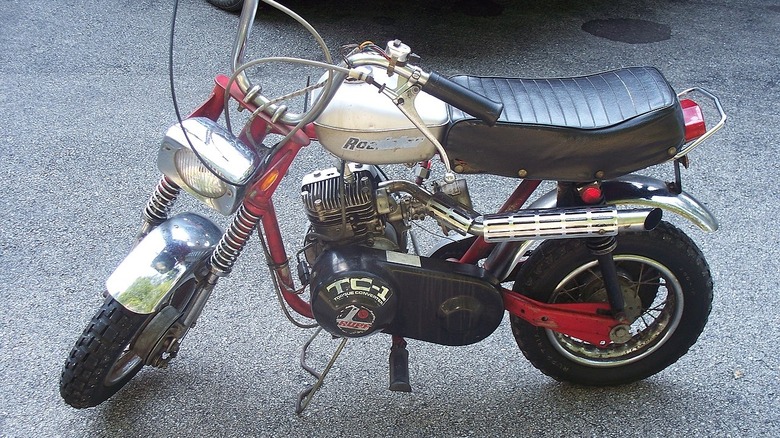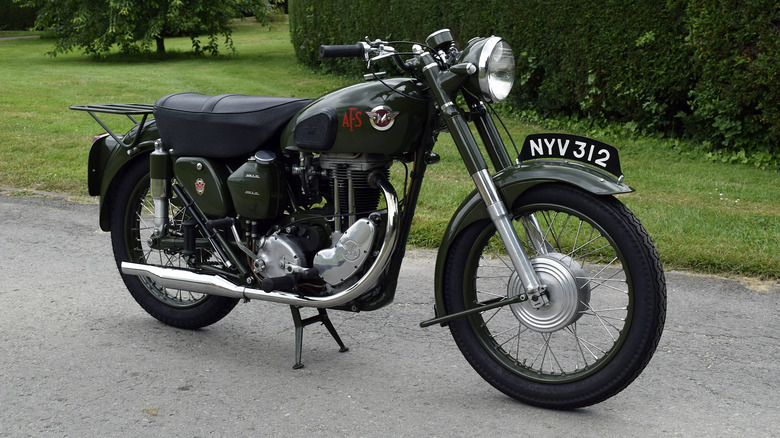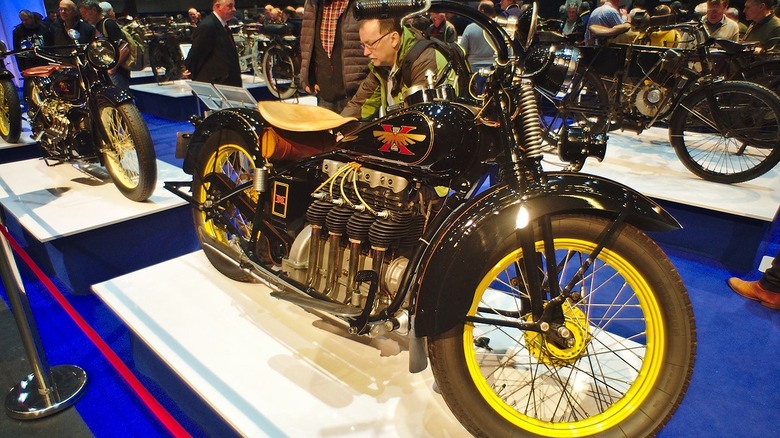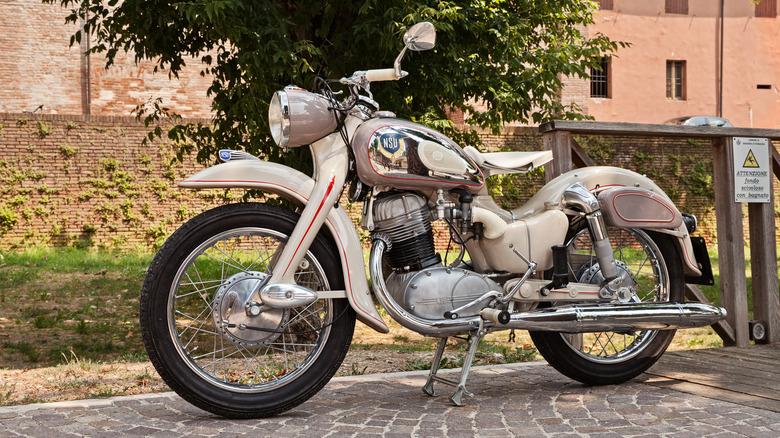10 Classic Motorcycle Brands That Aren't Around Anymore
It doesn't always take much for a storied auto manufacturer to go from boom to bankruptcy. Sometimes, it's as simple as one wrong decision by management, or a failure to anticipate a change in the market. In other cases, automakers are victims of their own success, buying up smaller companies only to realize they haven't got the resources to manage multiple brands. The same stories can be found across both the car and the motorcycle industries, and the result is nearly always the same: Revered marques are driven into bankruptcy, leaving enthusiasts to mourn their loss.
However, being axed doesn't always have to spell the end for a marque. Sometimes, it's bought out years or even decades later and successfully resurrected. Recent examples include the Norton Motorcycle Company, now under the ownership of TVS, or BSA, which was brought back to life by Mahindra in 2021.
We've rounded up some classic motorcycle brands from decades past that aren't around anymore, but that we think make similarly great candidates for revival. Some are currently in the hands of owners who plan to bring them back, while others seem extremely unlikely to make a return for the foreseeable future, if ever.
Ariel
Ariel might be best known today as the maker of the Atom sports car, but long before the company was resurrected in its current form, it was one of Britain's most influential motorcycle manufacturers. The company originally produced bicycles, but its first motorcycle was unveiled in 1901. After a successful launch, the company continued development of its motorcycle lineup until the outbreak of World War I saw the company pivot to producing bikes for the British Army.
After the war, Ariel returned to civilian motorcycle production, launching one of the most celebrated models, the Square Four, in 1931. The following year, another notable model, the 500cc Red Hunter, was unveiled. The breakout of war in 1939 again saw Ariel enlisted as a military supplier, and it would be another decade before the company would return to releasing new civilian models. The first all-new model to emerge from the post-war recovery was the 1949 VCH, which became highly successful in competition and re-established Ariel's name as one of the country's premier motorcycle makers.
Production of Ariel motorcycles continued throughout the '50s and '60s, but by the end of that decade, increased competition from Japan had driven down demand for British motorcycles as a whole. Under the ownership of BSA, itself formerly the world's largest motorcycle maker, Ariel had continued both the Red Hunter and Square Four nameplates, and their replacements never became as popular. Ariel was shuttered at the end of the '60s, eventually being relaunched as a carmaker in 1999.
Laverda
Originally specializing in agricultural machinery, Italian marque Laverda made the switch to producing motorcycles in the aftermath of the Second World War. The country's economy was in bad shape and workers needed cheap, reliable transportation — Laverda saw an opportunity and launched a 75cc motorcycle to cater to this emerging market. Production of these small motorcycles continued until the 1960s, when dwindling demand due to the rise of Italy's domestic automobile market meant that a change of tactics was needed.
The son of Laverda's founder convinced his father to pivot toward making larger, faster bikes, with the company unveiling a new 654cc model in 1968. The change proved to be a success, and over the following decade, Laverda would continue to develop ever faster and more powerful bikes, gaining international recognition in the process.
Slater Brothers, a British motorcycle importer, helped create one of the company's most famous models when they modified a 1000cc model with racing parts to create the 90 horsepower Jota. It was among the fastest motorcycles on the road at its launch in 1976, but also proved to be reliable. Unfortunately, Laverda's small sales volume meant that it lacked the development funds to keep up with larger brands, and it eventually ran out of cash altogether in 1986. The brand was relaunched in the '90s, but its motorcycles were considered largely underwhelming and it folded a few years after being resurrected. The brand is today owned by Aprilia, but remains dormant for now.
Bultaco
Originally a senior figure at Spanish motorcycle maker Montesa, Francesc Bultó decided to form his own motorcycle company in 1958. His decision stemmed from the fact that Montesa had decided to withdraw from competitive racing, abandoning a project Bultó had been working on as a result. Less than a year later, Bultó and a small group of engineers had developed a new model that would be sold under the Bultaco brand. It was a simple, lightweight two-stroke, designed specifically with racing in mind. It proved almost immediately successful, winning races against more powerful four-stroke machinery.
News quickly spread about the upstart racing brand, and before long, Bultaco was exporting its motorcycles to a multitude of countries. Among them was the United States, where the brand's bikes became dominant in trials and off-road competitions. Like many smaller manufacturers at the time, however, Bultaco faced increasingly stiff competition from larger, more well-funded Japanese rivals. Sales began to decline significantly in the 1970s as Japanese motorcycles were launched with better reliability, and by the turn of the '80s, Bultaco had collapsed.
Maserati
It remains a little-known fact among enthusiasts, but Maserati the carmaker briefly shared its name and logo with a maker of motorcycles, owing to a legal mistake. The loophole stemmed from the splitting of the Maserati manufacturing company into several smaller, legally distinct companies in the 1950s. An error in the legal process accidentally granted Maserati's spark plug manufacturing outfit the rights to use the Maserati name and Trident logo, and the company's new owner was quick to make the most of the branding.
The outfit promptly bought up a small motorcycle manufacturer and began selling small, cheap motorcycles under the Maserati name. Thanks to the high-profile racing successes of Maserati the automobile brand, Maserati motorcycles quickly became popular in Italy and even launched in certain international markets. However, financial troubles plaguing the company's owner spelled the end for the short-lived brand, with the last Maserati motorcycle being produced in 1960.
[Featured image by Arnaud 25 via Wikimedia Commons | Cropped and scaled | CC BY-SA 3.0]
Vincent
Philip Conrad Vincent was reportedly fascinated by motorcycles from a young age, and dropped out of Cambridge University to form his own motorcycle company. With backing from his family, who had amassed a fortune as cattle ranch owners in Argentina, Vincent bought the rights to the HRD Motors name in 1928. HRD had previously been helmed by racer Howard Raymond Davies, and new bikes would take advantage of his well-known status, being produced under the Vincent-HRD name.
A talented designer as well as a businessman, Vincent and his top engineer Phil Irving created both a unique suspension design and an innovative V-Twin engine. HRD-Vincent motorcycles gained a reputation as some of the fastest of their day, and as the company's status grew both domestically and internationally, the "HRD" branding was dropped.
The outbreak of the Second World War saw Vincent contracted by the government to make a variety of aircraft and marine components, and after the war, the company continued to build other machines and components alongside its motorcycles. However, slumping sales and an underwhelming public reception to Vincent's Black Prince prototype in 1954 saw the company wound up the following year.
Cagiva
Founded by the Castiglioni brothers in the late 1970s, Cagiva's success saw it acquire several of Italy's most notable motorcycle brands. The manufacturer originally sourced its engines from Ducati, but it completed a full buyout of the latter brand in 1985. Cagiva continued to produce bikes under both its own name and under the Ducati name, although there was some overlap between the two lineups. Over the next few years, Cagiva would also acquire Moto Morini, Husqvarna, and MV Agusta.
With so many brands to invest in, Cagiva struggled to consistently make money. Nonetheless, its founders always remained keen to continue their racing endeavors, and Cagiva-branded motorcycles clinched victories both on the track and in the Dakar rally thanks to the Ducati-engined Elefant. In the early 2000s, further financial woes saw MV Agusta positioned as the primary brand of the group, with the Cagiva name temporarily retired.
It was later reinstated in a limited capacity before being retired again in 2012. A change of company ownership in 2019 saw new plans drawn up for the Cagiva name to be relaunched as an electric motorcycle brand, but as of this writing, no further announcements have been made regarding the brand's future.
Rupp
From humble origins, the Rupp Manufacturing Company of Mansfield, Ohio helped spawn one of the biggest motorcycle crazes of the '60s and '70s. Founded by Mick Rupp in 1959, the company first built go-karts, before adding snowmobiles and minibikes to its roster a few years later. It was the minibikes that would turn out to be particularly successful, with Rupp's lineup of affordable mini-motorcycles offering younger riders a cheaper and zippier alternative to buying a full-size motorcycle.
A partnership with Sears in 1963 saw Rupp minibikes sold through the retailer's famous catalog, which further increased demand. All the while, Mick Rupp and his design team were constantly making iterative improvements to the range. The success was not to last, however: The company became publicly traded in 1970, and after a few less successful years of trading, Mick Rupp was removed from his own company by its shareholders. After a failed attempt at revitalizing its finances by developing larger bikes, the Rupp company declared bankruptcy in 1978.
[Featured image by Steelpulse90 via Wikimedia Commons | Cropped and scaled | CC BY-SA 3.0]
Matchless
One of many classic British brands that became a casualty of the onslaught of affordable Japanese motorcycles in the 1960s, Matchless (alongside its sister brand AJS) has a long history of producing quality bikes. Unlike other notable brands that forged their legacies in competition, Matchless was primarily known for its roadgoing offerings. However, in the earliest days of the company, Matchless did see some racing success, including a first- and second-place finish at the 1910 Isle of Man TT.
Matchless became known for its single-cylinder motorcycles, which remained in constant production until the company's demise in the mid '60s, albeit with some significant design changes over the decades. By the time Associated Motorcycles, the parent company of Matchless, ran out of cash in 1966, its roster of brands included Norton, among several other prominent names.
A buyout of the bankrupt firm saw only Norton receive significant development, with Matchless phased out shortly after the transfer of ownership. A brief revival of the marque in the '80s by the same manufacturer that made Triumph Bonnevilles under license didn't turn its fortunes around, with only a handful of bikes sold. Today, the Matchless brand name and imagery has been resurrected for a motorcycle-inspired clothing line, but despite a new concept bike being unveiled in 2014, no production plans have been confirmed.
Excelsior-Henderson
Reviving an historic brand can be an extremely costly task. The owners of the Excelsior-Henderson marque found this out the hard way in the 1990s, developing a Harley-rivaling cruiser that debuted in production form in 1998. Called the Super X, it drew considerable buzz, amassing a national network of dealers and close to 2,000 sales in its first year. However, the marque ran out of cash while trying to ramp up production, being forced to declare bankruptcy a year later.
The Excelsior-Henderson name already had a storied heritage, being two separate motorcycle manufacturers that were merged by parent company Schwinn in the late 1910s. Throughout the 1920s, the manufacturer built up a reputation for making quality bikes, but the Great Depression proved to be a fatal blow, with Schwinn axing the brand in 1931.
After the failed resurrection in the '90s, the rights to the company name were offered at auction in 2018, although the final bid for the lot fell short of its $1.9 million reserve and so didn't sell. Shortly after, Indian manufacturing conglomerate Bajaj revealed that it had bought the rights to the name, filing trademarks that seemed to indicate an imminent revival. To date, however, no further plans have been unveiled.
[Featured image by Thomas Vogt via Wikimedia Commons | Cropped and scaled | CC BY-SA 2.0]
NSU
German manufacturer NSU is best known to many car enthusiasts as the maker of the pioneering, but ultimately flawed, rotary-powered Ro80. Prior to its disastrous rotary venture, however, it spent several decades as one of Europe's largest motorcycle manufacturers. After its factories were severely damaged in World War II, NSU's recovery to reclaim its place as one of the biggest-selling motorcycle brands was all the more remarkable. By the mid '50s, the brand was selling close to 300,000 motorcycles per year.
As well as cranking out motorcycles in unprecedented volume, NSU was also racking up victories in racing, taking five world championship titles. In 1956, an NSU became the fastest motorcycle in the world, clocking 211 mph at the Bonneville Salt Flats in the hands of Wilhelm Herz. At the same time, however, sales of the brand's everyday motorcycles were declining, as German buyers increasingly switched to cars. This prompted NSU's ill-fated pivot to car manufacturing, with the ensuing financial losses so significant that they effectively bankrupted the company, forcing it to merge with Auto Union and become a subsidiary of VW Group.
